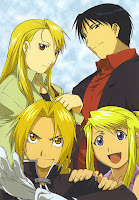Steins;Gate is going to have to go down as one of my all time favorite anime series. It's totally amazing. One of the reasons I'm so impressed with it is that it was developed from a game. It's been my experience that anime series developed from games are unfailingly horrible. By that light, Steins;Gate is more than amazing. It's an awesome series.
Spoiler Alert!!
 Steins;Gate is about a small group of misfits who learn to manipulate time-lines and world-lines. The story centers around a crazy guy name Okabe Rintarou (lab-coated guy in picture). By the end of the first episode, what you have found out about him is that Okabe is a stereotypical 'mad scientist' with a very loose grasp on reality, who also seems to be able to change that reality. I was totally hooked on the series after the first episode. Okabe calls himself Hyouoin Kyoma, talks to himself on his cell phone, has delusions of persecution (which turn out to be real), uses secret passwords, and has a 'lab' where he creates odd, apparently non-useful devices (like a microwave that turns bananas into green gel). His 'lab' is a place where misfits gather. He's totally a type of person you would write off as "eccentric" if you were feeling mellow, outright "crazy" otherwise. And in the first episode he sends a text message, and a girl he saw dead is now alive.
Steins;Gate is about a small group of misfits who learn to manipulate time-lines and world-lines. The story centers around a crazy guy name Okabe Rintarou (lab-coated guy in picture). By the end of the first episode, what you have found out about him is that Okabe is a stereotypical 'mad scientist' with a very loose grasp on reality, who also seems to be able to change that reality. I was totally hooked on the series after the first episode. Okabe calls himself Hyouoin Kyoma, talks to himself on his cell phone, has delusions of persecution (which turn out to be real), uses secret passwords, and has a 'lab' where he creates odd, apparently non-useful devices (like a microwave that turns bananas into green gel). His 'lab' is a place where misfits gather. He's totally a type of person you would write off as "eccentric" if you were feeling mellow, outright "crazy" otherwise. And in the first episode he sends a text message, and a girl he saw dead is now alive. Okabe's efforts to create a time machine are helped by his lab group, comprised of seven individuals who are variously either part of Okabe's schemes or are dragged into them. The individuals are shown in the picture and include Mayuri (blue dress), who Okabe treats as a little sister and takes care of, Hashida (yellow cap), a hacker/pervert, and Makise Kurisu (Chris) (red hair), a genius-level time researcher who's drawn into the group.
The plot goes like this: Okabe-tachi figure out how to use their malfunctioning microwave and a cell phone to send text messages to the past. Each message they send alters the past and moves Okabe to a new world-line. Okabe is the only one of the group who remembers everything from all the world-lines and pasts. For all the other members, the new world-line is their past and they have no conscious memory of what may have happened in the other world-lines. So they play with sending text messages that they call "D-mail" and each one sends a text that changes their past. The upshot of this time-line tampering is that they come to the attention of a serious group (SERN) who is also manipulating time, and SERN comes to kill them all. Mayuri dies.
At the time SERN attacks and Mayuri dies, Okabe and Chris are perfecting a way to send Okabe himself through time, so he uses it to jump back and save Mayuri. He uses it again and again and again, and gets to see Mayuri die, again and again and again. He finally enlists Chris's aid and they figure out that the only way to save Mayuri's life is for Okabe to get back to his ORIGINAL world-line. Which means he has to undo all the D-mails that were sent, one by one, in the reverse order that they were sent. Each D-mail reversal requires him to come face to face with that character's wishes and dreams and change them back. Chris helps him each time although he has to explain it to her each time since her memory is gone whenever he switches world-lines. Finally he reaches a time-line and realizes that reversing the last D-mail will take him back to the original time-line, the one in which Chris died before he sent that first D-mail! He will save Mayuri, but Chris will die.
This anime is just awesome. The music is good, the plot is outstanding, the characters are quirky, and the whole package is just incredibly well done. The pacing is wonderful . . . not so fast you miss the details, nor so slow you get bored. It's heart-wrenching through the episodes that Okabe spends jumping back again and again to try to save Mayuri. I found it amazing that when Okabe reached the final decision point, I realized, right as he did, that his first D-mail had saved Chris' life. It was in the first episode and at that time I didn't even know what was going on.
How does it end? Nobody dies! They do an outstanding job of making you worry right up until the end, but it's a happily-ever-after ending.
This is the bare bones of the series of course. So much happens with the various characters that I haven't talked about here. It all just adds in to making the series as great as it is. If you haven't watched this series, I recommend you do. I'm going to watch it again.























































